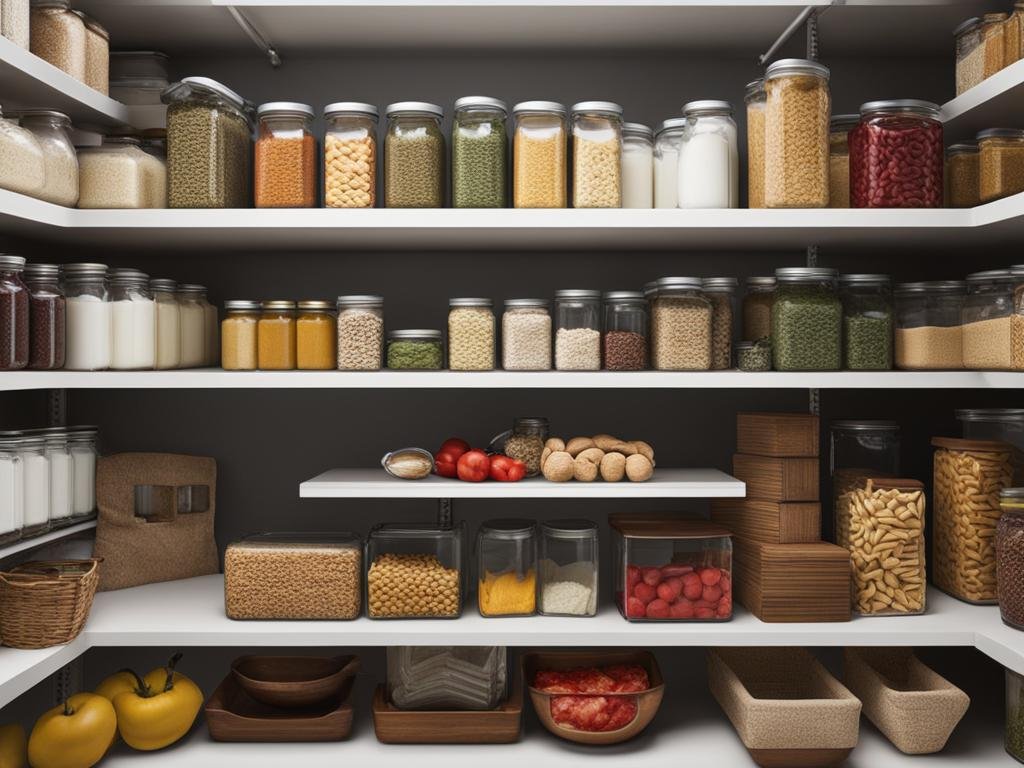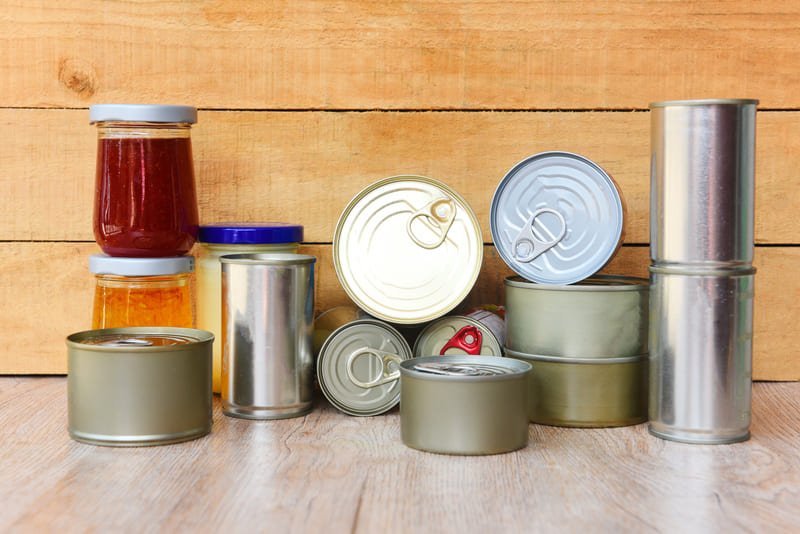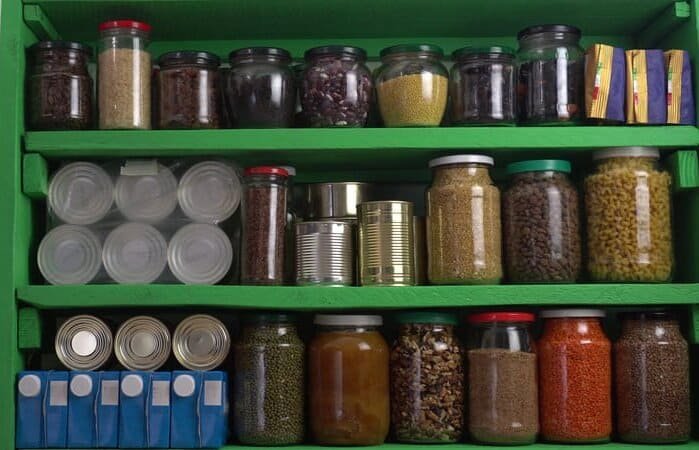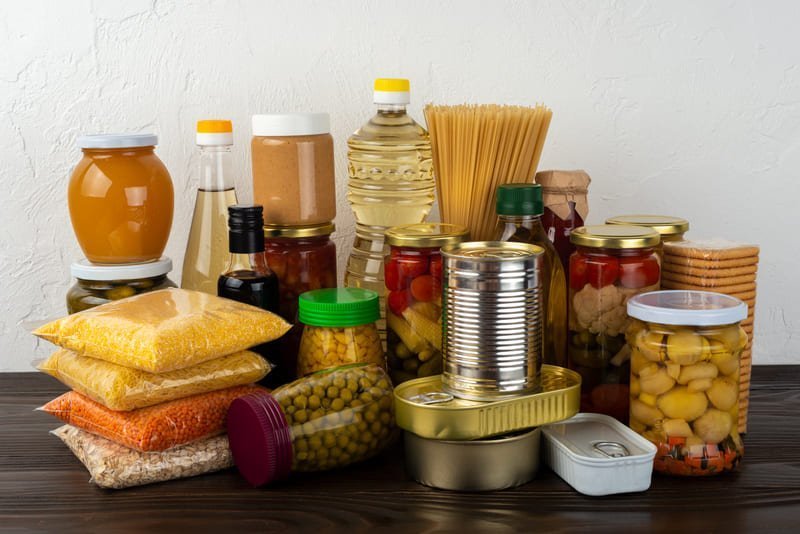Building an emergency food pantry is a crucial step in ensuring food security and hunger relief during times of need. Whether it’s due to a natural disaster, a personal emergency, or a global crisis, having a well-stocked pantry can provide essential sustenance when resources are limited. In this guide, I will share valuable information and tips on how to create and maintain an emergency food pantry. From selecting the right foods to understanding shelf life and storage methods, I will walk you through the process of being prepared for any emergency situation.
Key Takeaways:
- Building an emergency food pantry is essential for food security and hunger relief.
- Select foods with long shelf life and durable packaging when shopping for emergency food.
- Shelf-stable and non-perishable foods are ideal for emergency pantries.
- Include essential foods like grains, beans, fats, and canned meats in your emergency pantry.
- When donating to local food banks, focus on non-perishable and shelf-stable items.
What to Look for When Shopping for Emergency Food
When shopping for emergency food, there are a few key factors to consider. First and foremost, prioritize foods with a long shelf life, typically lasting at least a year, to ensure that they will be available when you need them most. Look for durable packaging, such as cans or boxes, that can withstand the test of time. Additionally, consider the ease of preparation, as you may not have access to utilities or other cooking facilities during an emergency. Nutritional value and calorie density should also be taken into account, as well as any dietary restrictions or preferences within your household.
By carefully selecting the right foods, you can ensure that your emergency food pantry will provide nourishment and sustenance during challenging times.
Factors to Consider When Shopping for Emergency Food:
- Shelf life: Look for foods with a long shelf life, lasting at least a year.
- Durable packaging: Choose cans or boxes that can withstand storage conditions.
- Easy preparation: Opt for foods that require minimal or no cooking.
- Nutritional value: Consider the nutritional content of the food items.
- Calorie density: Select foods that provide a good amount of calories.
- Dietary restrictions: Take into account any specific dietary needs or preferences.
“By carefully selecting the right foods, you can ensure that your emergency food pantry will provide nourishment and sustenance during challenging times.”
| Food Item | Shelf Life | Packaging | Preparation | Nutritional Value | Calorie Density | Dietary Restrictions |
|---|---|---|---|---|---|---|
| Canned fruits | Up to 2 years | Durable cans | Ready to eat | Good source of vitamins | Provides energy | May not be suitable for low-sugar diets |
| Dried beans and legumes | Indefinite if stored properly | Airtight packaging | Requires soaking and cooking | High in protein and fiber | Provides sustained energy | May not be suitable for low-carb diets |
| Ready-to-eat canned soups | Up to 2 years | Durable cans | Heating required | Varies depending on the soup | Provides a substantial meal | May not be suitable for low-sodium diets |
| Dehydrated fruits and vegetables | Up to 2 years | Airtight packaging | Can be eaten as-is or rehydrated | Retains most nutrients | Provides vitamins and minerals | May not be suitable for low-fiber diets |
By considering these factors and selecting a variety of food items that meet your specific needs, you can ensure that your emergency food pantry is well-equipped to provide nourishment and sustenance during challenging times.
The Basics of Shelf-Stable and Non-Perishable Foods

Understanding the concept of shelf-stable and non-perishable foods is essential when building an emergency food pantry. Shelf-stable foods are those that can be safely stored at room temperature and do not require refrigeration until after opening. These foods include canned and bottled products, rice, pasta, flour, sugar, spices, and more. Non-perishable foods have a long shelf life and can last for years if stored properly. It is important to note that not all canned goods are shelf-stable, as some may require refrigeration.
By focusing on shelf-stable and non-perishable foods, you can ensure that your emergency food pantry is stocked with items that will remain safe and edible during extended periods of time.
| Shelf-Stable Foods | Non-Perishable Foods |
|---|---|
| canned goods (e.g., fruits, vegetables, soups) | grains (e.g., rice, pasta, oats) |
| bottled sauces and condiments | canned meats (e.g., tuna, chicken) |
| flour, sugar, and spices | beans and legumes |
| shelf-stable milk and dairy alternatives | fats (e.g., peanut butter, vegetable oils) |
By having a well-rounded selection of shelf-stable foods, you can create balanced meals that provide essential nutrients and energy. Non-perishable foods like grains and canned meats can be easily incorporated into a variety of recipes. Make sure to rotate your pantry stock periodically and check expiration dates to ensure the freshness of your emergency food supply.
Essential Foods for Your Emergency Pantry

Building a well-stocked emergency food pantry is crucial for ensuring food security and preparedness during times of need. By including a variety of essential foods, you can provide nourishment and sustenance for you and your loved ones. Here are some key food items that should be included in your emergency pantry:
Grains
Grains are an excellent source of carbohydrates and can be stored for extended periods. Consider stocking up on:
- Rice
- Wheat berries
- Oats
Beans and Legumes
Beans and legumes are packed with protein and fiber, making them a nutritious and versatile option. Add these to your emergency pantry:
- Black beans
- Chickpeas
- Lentils
Fats
Fats provide energy and can be used for cooking. Make sure to include:
- Peanut butter
- Vegetable oils
Canned Meats
Canned meats are a great source of protein and can be eaten straight out of the can. Stock up on:
- Tuna
- Chicken
Canned Fruits, Vegetables, and Beans
Canned fruits, vegetables, and beans can provide a variety of nutrients and flavors to your emergency meals. Consider including:
- Mixed fruit cocktail
- Green beans
- Black-eyed peas
By ensuring a well-rounded selection of these essential foods in your emergency pantry, you can have peace of mind knowing that you are prepared for any unforeseen circumstances. Remember to regularly check expiration dates and rotate your stock to maintain freshness and quality.
Emergency Pantry Essentials
| Food Category | Examples |
|---|---|
| Grains | Rice, wheat berries, oats |
| Beans and Legumes | Black beans, chickpeas, lentils |
| Fats | Peanut butter, vegetable oils |
| Canned Meats | Tuna, chicken |
| Canned Fruits, Vegetables, and Beans | Mixed fruit cocktail, green beans, black-eyed peas |
Donating to Local Food Banks: What to Give and What to Avoid

Donating to local food banks is a powerful way to make a difference in your community and help individuals and families facing food insecurity. By providing essential food assistance, you can contribute to alleviating the ongoing hunger crisis and supporting those in need.
When considering what items to donate, it is important to focus on non-perishable and shelf-stable foods that can withstand storage for extended periods. These foods are essential for emergency food pantries, as they have a longer shelf life and can be easily distributed to individuals who require immediate food support.
Peanut butter, canned soup, fruits, vegetables, and beans are highly sought after and can significantly contribute to providing a well-rounded food pantry for those in need.
However, it is equally important to be mindful of what to avoid donating. Perishable items such as fresh produce, dairy products, and other foods that require refrigeration should not be donated to food banks, as they have a shorter shelf life and pose storage challenges. Additionally, expired food, leftovers, and items with damaged packaging should be discarded and not donated.
“By donating thoughtfully, you can ensure that the food banks receive items they can distribute effectively and efficiently to those who need them the most.”
It’s important to note that while certain perishable items may not be suitable for food bank donations, many organizations have established partnerships with local farmers, retailers, and other organizations to source fresh produce and other perishable foods for distribution. This ensures that individuals and families have access to a diverse range of food options, promoting overall food security and well-being.
Together, we can make a lasting impact on the hunger crisis by providing food support to those who need it most. Let’s come together as a community, donate thoughtfully, and play a role in nourishing lives.
Conclusion
Building and maintaining an emergency food pantry is a proactive step towards ensuring food security and hunger relief in times of need. By selecting the right foods, understanding shelf life and storage methods, and donating thoughtfully to local food banks, you can make a significant impact in addressing the hunger crisis and supporting your community.
Remember, a well-stocked emergency food pantry provides not only sustenance but also peace of mind during challenging times. Start building your pantry today and be prepared for any emergency that may come your way.
Together, we can make a difference in providing food assistance and emergency meal distribution to those facing adversity. Let’s work towards a future where no one goes hungry.
FAQ
Why is building an emergency food pantry important?
Building an emergency food pantry is important because it ensures food security and hunger relief during times of need, such as natural disasters, personal emergencies, or global crises. Having a well-stocked pantry provides essential sustenance when resources are limited.
What should I look for when shopping for emergency food?
When shopping for emergency food, prioritize foods with a long shelf life, durable packaging, ease of preparation, nutritional value, calorie density, and consider any dietary restrictions or preferences within your household.
What are shelf-stable and non-perishable foods?
Shelf-stable foods can be safely stored at room temperature and do not require refrigeration until after opening, while non-perishable foods have a long shelf life and can last for years if stored properly.
What essential foods should be included in my emergency pantry?
Essential foods for an emergency pantry include grains (rice, wheat berries, oats), beans and legumes, fats (peanut butter, vegetable oils), canned meats (tuna, chicken), and canned fruits, vegetables, and beans.
What should I donate to local food banks?
When donating to local food banks, focus on non-perishable and shelf-stable foods that are in good condition and have not reached their expiration date. Peanut butter, canned soup, fruits, vegetables, and beans are often in high demand.
What should I avoid donating to food banks?
Avoid donating perishable items, expired food, leftovers, and food with damaged packaging. Food banks often have other sources for fresh produce and perishable foods.













